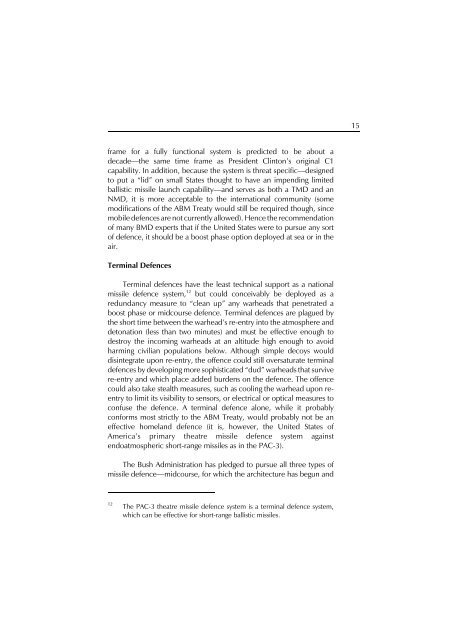Missile Defence, Deterrence and Arms Control - UNIDIR
Missile Defence, Deterrence and Arms Control - UNIDIR
Missile Defence, Deterrence and Arms Control - UNIDIR
You also want an ePaper? Increase the reach of your titles
YUMPU automatically turns print PDFs into web optimized ePapers that Google loves.
TECHNICAL ASPECTS OF MISSILE DEFENCE<br />
<strong>Missile</strong> defence systems are comprised of a broad array of technical<br />
measures designed to target incoming missiles—either ballistic or<br />
cruise—at some point along their flight trajectory. Short-range theatre<br />
ballistic missile defences, such as the Patriot Advanced Capability (PAC-<br />
3) system which the United States employed to protect its forces <strong>and</strong><br />
allies vulnerable to Iraq’s Al-Hussayn Scud-derivative missiles, were the<br />
subject of much attention during the Gulf War. Since a short-range<br />
ballistic missile is powered for most of its flight, <strong>and</strong> thus has a plume of<br />
hot gases trailing it, missile interceptors have a relatively welldifferentiated<br />
target to hit. In addition, short-range ballistic missile flight<br />
trajectories are entirely endoatmospheric, which affords tracking,<br />
sensory, <strong>and</strong> targeting advantages. As such, the United States has been<br />
able to develop rather sophisticated, albeit debatably effective, shortrange<br />
theatre missile defences for tactical wartime scenarios where its<br />
troops or allies are at risk.<br />
A natural technical extension of short-range ballistic missile defences<br />
such as the Patriot system is intermediate <strong>and</strong> long-range ballistic missile<br />
defence systems which, instead of targeting missiles in tactical situations,<br />
aim to defend against an entirely different class of missiles that target a<br />
State’s homel<strong>and</strong>. Lately, this class of ballistic missiles has received the<br />
most attention, with the United States pledging to deploy some version<br />
of ballistic missile defence by the end of this decade, if not sooner.<br />
Unlike cruise missiles, which are powered for the entirety of their flight,<br />
ballistic missiles are powered only for part of theirs—thereafter they<br />
move under the influence of their own momentum <strong>and</strong> gravity.<br />
Employed as the primary delivery vehicle of strategic nuclear weapons,<br />
the flight path of a ballistic missile is divided into three distinct stages.<br />
Boost Phase<br />
The first stage is termed the boost phase, where the<br />
warhead—which can be conventional, nuclear, chemical or<br />
biological—is mounted on a single or multistage booster. Various types<br />
of rocket boosters have been developed across the world, with more<br />
advanced boosters employing solid fuel or cryogenic systems as opposed<br />
5








